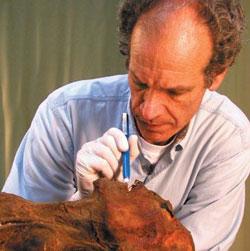Mr. Mummy Speaks!

If you want to learn about a famous battle led by Pharoh Ramses III, you'll have no problem at all. A papyrus documenting that event is remarkably detailed, declaring not only the precise number of casualties but also the names of the horses that pulled Ramses' chariot.
"I guess it was a trade secret," says celebrated Egyptologist and philosophy professor Bob Brier, who was vexed by the unanswered questions that lingered, such as whether blood was drained, what tools were needed and how much dehydrating compound was used. So he decided to retrace the Egyptians' steps.
On Thursday, Dec. 6, Brier will describe his experiences and findings during a public lecture, Mummification: Resurrection of an Ancient Art. The event is presented by the archaeology department and sponsored by the Archaeological Institute of America's South Pennsylvania Society.
As a National Geographic film crew chronicled his progress, Brier harvested 400 pounds of the salt-and-baking-powder-like natron compound at a spot the ancients favored. He tested it on-site to ensure that the substance remained pure. Then he brought it back to a lab at the University of Maryland Medical School, filming crew in tow.
Brier's groundbreaking project provided perfect footage for National Geographic's compelling documentary Mr. Mummy, which, in turn, supplied a memorable moniker for the man. And Brier, who enters his 33rd year of teaching philosophy and Egyptology at Long Island University Post, did not stop there. Since 2004 he's published several books and has advanced a theory that King Tut was murdered in 1336 B.C. by his prime minister. His research found a wider audience when the Discovery Channel and TLC aired television specials about his work investigating the three "wise men" of Christian lore, the Medici dynasty and Pharaoh Ramses III.
"We have a very different relationship with death and the dead than did the ancient Egyptians and other societies who mummified," says Bruno, who researches ancient South American cultures, in which loved ones may take mummified loved ones out of their tombs for special occasions to include them in the celebration. "Perhaps we also just have a great appreciation and fascination with the technical knowledge some of these ancient cultures possessed."
"Mummies are little encyclopedias," Brier likes to say, noting that much of what we know about the ancient Egyptians' culture and daily lives arises, directly or indirectly, out of what they believed about life after death. "You've just got to know how to read them."
Published November 28, 2012